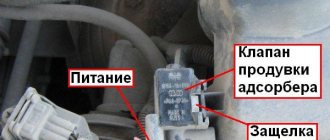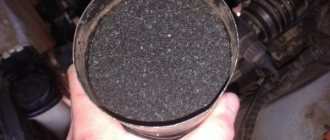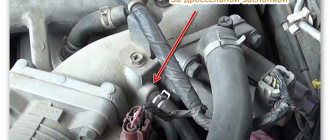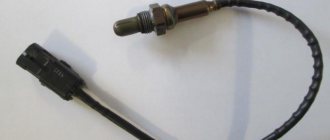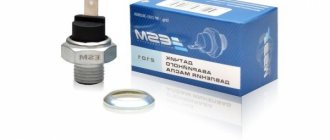Injection system on Kalina
The system that serves in the Kalina car to capture fuel vapors prevents their unplanned leakage into the atmosphere. These vapors are formed due to heating of the fuel in the gas tank, as well as when atmospheric pressure decreases. The vapors do not escape, but accumulate in the system; when the engine starts, they enter the intake manifold and burn in the power unit. To regulate the flow of fuel evaporation from the adsorber into the intake manifold receiver, the Kalina adsorber purge valve is used. This valve is installed on all cars with an injection-type engine. Its location is usually under the hood.
The system includes a special adsorbing mechanism consisting of technical activated carbon, a special valve with an electric-magnetic pulse and functional pipelines suitable for it.
The entire system is based on a so-called adsorber, which is capable of collecting all the fumes from the gas tank. Small granules of technical activated carbon, which are part of the absorbent part, absorb gasoline vapors and retain them inside.
The canister valve is knocking, clicking or clicking
We make sure that the noise comes specifically from the adsorber valve, and not from the timing belt, rollers and other elements. To do this, simply press the gas pedal sharply. If the chattering noise does not change, then the source of the noise is the adsorber valve. It is not uncommon for the clatter of the adsorber valve to appear only in cold weather at sub-zero temperatures.
1. Contact an authorized dealer with the problem. If the adsorber valve is truly faulty, it will be replaced under warranty. If they consider that such valve operation is the norm, then there is no point in writing in support of AvtoVAZ.
2. Advice from car enthusiasts (you lose your warranty!). There is an adjusting screw on the side of the valve, which is filled with glue. Remove the glue and turn the screw clockwise 90 degrees. After this, the adsorber valve no longer clicks in the cold.
Keywords: sound insulation lada xray | sound insulation of Lada Vesta | sound insulation of Lada Largus | soundproofing of Lada Granta | sound insulation of Lada Kalina | sound insulation of Lada Priora | soundproofing 4x4 | lada xray sensors | Lada Vesta sensors | Lada Largus sensors | Lada Granta sensors | Lada Kalina sensors | Lada Priora sensors | 4x4 sensors | ECM Lada Vesta | ECM Lada XRAY | ECM Lada Largus | ECM Lada Granta | ECM Lada Kalina | ECM Lada Priora | ECM 4x4 | universal article
Found an error? Select it and press Ctrl Enter..
Signs of a malfunction of the control unit
First, start the engine: at idle or in cold weather, you will hear a characteristic, barely audible chirping sound. It indicates that the valve is working properly. In order not to confuse this sound with the noise from a working timing belt, sharply press the gas. The character of the chatter should not change. The following signs indicate a malfunction of the control unit:
- lighting of the CHECK signal on the instrument panel;
- determination of error PO441 during testing;
- increased gasoline consumption;
- unstable operation of the power unit when driving;
- unstable idle;
- increase in CO2 content;
- a hissing sound when unscrewing the tank lid (a vacuum has appeared);
- the appearance of a fuel smell in the cabin.
Related article: Error P0134 – lack of oxygen sensor signal
Malfunctions in the fuel vapor recovery system Lada Kalina
Since the solenoid valve itself is not a complex device, it has few malfunctions as such - it may not open or close when necessary, or may freeze in a certain position. But the culprit of the breakdown may not only be Evap-Solenoid; the gasoline vapor recovery system does not work correctly for other reasons:
- connecting pipes are pinched or clogged;
- normal vacuum is not created in the system;
- due to an open circuit, there is no voltage on the valve;
- the carbon filter is completely clogged (which is rare);
- The control unit malfunctions.
If the CPA is stuck in the open position and does not block the channel, the following defects may occur:
- the fuel mixture becomes richer, causing “blackness” to appear on the electrodes of the spark plugs;
- the engine begins to operate unstably, this is especially noticeable at idle;
- gasoline consumption increases;
- The throttle response of the internal combustion engine decreases.
When the EVAP channel is constantly blocked by the purge valve, excess vapor pressure is created in the gas tank, due to this:
- there is a risk of fuel pump failure;
- The fuel level sensor may fail.
It should be noted that purge occurs in a certain mode after starting the engine, the program is executed depending on the crankshaft speed, and the system does not work at idle. An impulse arrives at the CPA if:
Similar articles
How to check the adsorber valve using the Lada Kalina as an example
- the coolant has heated to a temperature of at least 75 degrees Celsius;
- the throttle valve is open at least 4%;
- the car is moving at a speed of more than 10 km/h (but this is not a necessary condition).
Problems in the electrical part of the EVAP are detected by the control unit, and the Check Engine warning lamp lights up on the instrument panel. The fault code can be determined using a special diagnostic scanner or a computer with a program installed; the most common errors in the vapor recovery system detected by the diagnostic device are P0441 and P0455.
The principle of operation of the fuel system
An adsorber is a small part in a car designed to collect all gasoline vapors. The system allows fuel vapors to accumulate in a specially designed place called a separator, converting them into condensate and releasing them into the gas tank.
Valve on car
Untreated gasoline vapors pass through double system valves. The first valve is gravity and serves to protect fuel from leaking out of the gas tank during an emergency vehicle rollover. The second valve regulates the pressure created in the fuel tank.
Passing through the entire fuel system, gasoline vapors reach the adsorbing chamber and are absorbed by the activated carbon contained in it. When the engine starts, the purge valve starts to operate. If it is faulty, this may result in a loss of power from the power unit and increased fuel consumption.
The adsorber purge valve is installed inside the device filled with activated carbon. The device itself is located on the gas tank. The purge system is designed to ensure that everything functions correctly and without interruption. Ventilation and condensate removal are the main purpose of this electromechanical unit.
The adsorber valve is knocking on Kalina
Many owners of Lada Kalina cars are faced with a problem - while the engine is running, an incomprehensible clattering sound is heard from under the hood; when identifying the cause of the noise, it turns out that the sound comes from the purge valve. Although the knocking does not affect the operation of the car in any way, some car owners are annoyed by it, and car owners want to get rid of it. You can “overcome” the unpleasant clattering sound; you just need to do the following:
- remove the valve and inspect it carefully;
- Find the adjusting screw on the side; it will be filled with epoxy resin on top;
- pick out the epoxy, tighten the screw half or three-quarters of a turn;
- install the valve in place, check for changes in the operation of the internal combustion engine.
You cannot tighten the screw any more, in this case the control panel will stop opening, and the engine diagnostic lamp on the instrument panel will record an error. It is also worth noting that some drivers confuse the clatter of the solenoid valve with detonation, but in principle, the sounds can be distinguished. You just need to take into account that detonation occurs under load, for example, when a loaded car is moving uphill, in this case they say “fingers are ringing.”
Replacing the adsorber purge valve on Kalina
If the check shows that the Evap-Solenoid is faulty, the part must be replaced (catalog number - 11181164200). There is no point in repairing the device:
- the price of the valve is in the range of 400-800 rubles;
- You can buy the device in almost any store that sells VAZ spare parts;
- changing the KPA is very easy and simple.
But before making a replacement, it would be a good idea to check the control circuit; quite often the valve does not work due to a break in the wires going to it. To complete the work, you will not need a pit or a lift, and the procedure itself will take no more than one to two hours, even if the operation is performed by an inexperienced worker without metalworking skills.
We change the valve as follows:
- turn off the ignition, raise the hood;
- we find Evap-Solenoid, it is located just below the air duct, on the air filter housing (indicated by an arrow in the figure below):
- just in case, disconnect the negative terminal from the battery;
- move the plug tab to the side and disconnect the wires;
- so that the air flow sensor does not interfere, use a Phillips screwdriver to loosen the clamp securing the air duct, and move the pipe to the side. For convenience, the air flow sensor can be removed;
- Now access to the valve is free, all that remains is to gently pull it up to pull it out of the grooves;
- but that’s not all - since the tube on the valve itself is sealed, we do not touch this connection for now, it is necessary to release the other end of the hose, to do this we remove the latch and pull the pipe out of the connection;
- We dismantle the valve together with the tube, and the disassembly is almost complete.
Replacing the purge valve could be considered a very simple task, if not for one “but” - it is very difficult to remove the plastic tube from the CPA without damaging it, and it does not come with the new valve. There are two options here:
try to carefully heat the connection with a hairdryer and pull off the pipe; cut the tube at the connections, and instead buy an ordinary fuel hose with a diameter of 8 mm and two clamps.
Having measured the required length of the hose, cut it, connect it to the valve and connector, we get approximately the same design as in the figure below.
Similar articles
What is a VAZ-2114 adsorber and what is it for?
We install everything in place, start the engine, and test the car on the move.
Removing and installing a new valve on Kalina
The only tool you need for this procedure is a Phillips screwdriver. The work will not take much time and effort and can be done independently in a garage. First, you should disconnect the negative terminal of the battery and remove the power plug of the piston compressor (KPA).
In a Lada Kalina car, access to the valve is slightly difficult, so you will need to slightly loosen the clamp from the inlet pipe and remove it from the mass air flow sensor. Move everything unnecessary to the side so that it does not interfere with work, and secure it during repairs.
Replacing a valve on a car
If the mass air flow sensor interferes greatly, it can be dismantled, but it is better to simply move the valve mount to the side a little and remove it without any problems. The fastener must be bent a maximum of 1 cm and, with some effort, pull the valve up in the direction of the grooves. If everything is done correctly, the part will be removed quite easily and quickly.
Finally, it is necessary to disconnect the fittings from the system. One of them can be removed easily and without problems, but the second one will have to be tinkered with, since it is secured with a special latch. To release the second fitting from the grooves, you need to press slightly on the latch and use a suitable sharp object to pry the antennae, slightly moving the fitting to the side.
Installation of the valve is carried out in the reverse order of dismantling. It is important to consider that when replacing a valve on a Lada Kalina, you should pay attention to the markings: they must match for the old and new parts.
How to check the adsorber valve? Attach a regular medical syringe with the piston extended a short distance (2-3 cm) to the outlet fitting. To make connection more convenient, you can use a vacuum supply hose. Press the plunger of the syringe. If there is pressure in the valve, the syringe plunger will be difficult to press and tend to return to its original position.
Then you should connect a source of direct electric current with a voltage of 12 V to the valve and repeat the procedure with the syringe. In this case, the pressure inside should disappear, the valve will now open, and the syringe piston will easily move all the way down. If this does not happen, the valve must be replaced.
Error P0441
Owners of Lada Kalina often note that during the operation of the car, error P0441 appears, indicating that the gasoline vapor purge system is not operating correctly (the air flow differs from the norm). The cause of this malfunction may be:
- inoperative adsorber valve;
- clogging of the air line from the control unit to the air filter;
- air leakage through connecting pipes.
What should not be immediately considered is the line from the gas tank to the adsorber; here, a breakdown does not in any way affect the readings of the computer or diagnostic scanner. Still, most often Evap-Solenoid fails; this is a characteristic “disease” on Kalina.
If the EVAP valve stops functioning normally, it is not at all necessary that the engine will lose power, the fuel pump will fail, and so on. Mainly due to problems with the control gear, exhaust toxicity increases, and the Check Engine on the dashboard periodically lights up. There are car owners who do not pay attention to the diagnostic warning light, continuing to operate the car, but do not experience any great inconvenience. And most often in such a case, gasoline consumption does not exceed the norm, the engine starts normally, and no serious problems occur in the fuel system.
Components
In fact, this is a large plastic jar with activated carbon inside, because it is this composition that perfectly fights gasoline vapors. The main parts can be described as follows:
- Separator + gravity valve
- Pressure meter
- Filter part (usually carbon)
- Connecting tubes
- Solenoid valve
As you can see, there is absolutely nothing complicated. Separator - serves to catch part of the gasoline, then sends it back to the tank. Gravity valve - almost never used, but it is needed in emergency situations, for example during accidents, it prevents fuel from overflowing from the tank (for example, when a car overturns).
The pressure sensor is a very necessary thing - it monitors the pressure of gasoline vapors inside the tank, if necessary, it opens and resets it, preventing the structure from being damaged.
Similar articles
How to dry the valves of a VAZ 2112 16 valves
The filter part is, as I wrote above, a large jar into which coal powder is poured, in fairly large granules. This is done so that vapors can pass and condense freely.
Connecting tubes are needed to connect all the main parts, filters, sensors and valves, I think this is clear.
Solenoid valve - used to switch modes for capturing gasoline vapors, we will talk about it in more detail below.
Checking the canister purge valve
1. Disconnect the block with wires and visually check the condition of the contacts. If oxides are detected on them, we treat the terminals with a means for cleaning and protecting electrical contacts.
2. Remove the adsorber valve. We measure the resistance of the valve winding with a multimeter, which should be within 20-30 Ohms. The canister valve should be replaced if a short circuit or break is detected in the valve winding.
3. To avoid short circuit, one terminal of the valve should be insulated with PVC pipe. We supply 12 V from the battery to the valve terminals. At this moment, the valve terminals should open with a characteristic click. We repeat the test, creating a vacuum in the valve with a rubber bulb.
Adsorber on Lada Kalina - can I repair it myself?
An electromagnetic valve, called an adsorber, is present on every engine with injection type injection. However, few people realize why this detail is needed. The adsorber is designed to accumulate fuel vapors that are heated in the fuel tank. Thus, when the engine starts, it is the vapors accumulated by the adsorber that enter the manifold and combustion chamber, for which a special purge valve is responsible, which regulates the condensate and ventilates the system.
1 Principles and features of the adsorber operation
To control the amount of fuel vapor entering the combustion chamber, a special purge valve is installed on each car model with an injection-type engine, usually in the area of the gas tank. In general, an adsorber is a system consisting of several valves, each of which is responsible for certain parameters. Thus, the gravity valve prevents fuel overflow in emergency situations, and the pressure sensor, accordingly, regulates the pressure in the gas tank. In addition, the adsorber includes a carbon filter, an electromagnetic sensor and special connecting tubes for system integrity.
As for the adsorber for the Lada Kalina model, if this mechanism malfunctions, the car’s fuel consumption increases and the power level decreases significantly. However, recently experts have disagreed as to how exactly a malfunction of the adsorber affects the behavior of the engine and the car. In any case, the adsorber is an important component of the fuel system, the components of which must be repaired and replaced if malfunctions are detected.
2 Diagnostics of adsorber valves and the possibility of self-repair
If the canister valve on your car is faulty, this can lead to a variety of consequences for the fuel system and engine. Firstly, due to insufficient and poor-quality ventilation of the system, the fuel pump may suffer, and secondly, the gradual accumulation of fuel in the manifold can lead to failures during engine operation. If your Lada Kalina “chokes” at idle or significantly loses traction, the adsorber sensor may be to blame. To determine whether the adsorbing mechanism on the Lada Kalina model is working, you need to open the gas tank after stopping the car and listen. If a characteristic “hissing” sound is heard from the gas tank area, this is the first sign of a malfunction of the ventilation valve in the adsorber.
In addition, the smell of gasoline in the cabin may indicate a malfunction. In this case, the adsorber must be replaced immediately to avoid more serious consequences for the engine. Of course, the smell of gasoline in the cabin may be caused by other reasons, but if all other elements of the fuel system are working properly, then the problem is in the purge valve, which you can replace with your own hands.
3 Installing a new adsorber valve with your own hands
The work of dismantling a faulty valve and installing a new one is not difficult. To do this, you will need a Phillips screwdriver and the information you will learn in this article. In the case of the Lada Kalina car, “getting” the adsorber valve will be a little more difficult than in other models, but again, there is nothing complicated. You must first remove the negative terminal from the battery, then loosen the fastening and try to remove the valve, applying a certain force. To finally remove the valve from the mount, it is also necessary to remove the fittings that are located under the latch. Then it is imperative to check the markings of the removed and new purge valve so that they match. If everything is done correctly, you need to do the same work in reverse order, and the new valve will fit into place without any problems.
In addition, on the Lada Kalina model you can independently carry out not only diagnostics, but also repair of the adsorber, but for this you need to have certain knowledge. It is better to entrust this to specialists, especially since the price of such work will be relatively low.
How to understand a malfunction of the absorber
Speaking about the adsorber valve, the symptoms of a malfunction will be fairly standardized, which makes it possible to obtain a fairly detailed description. So, signs of a malfunctioning adsorber valve:
– Constant smell of gasoline in the cabin.
This fact is caused by improper circulation of gases, which may have a certain leakage. Due to the proximity of the system to the air filter, odors freely penetrate into the cabin.
- Valve knock.
Signs of a malfunction of the canister purge valve on the Grant include this sound, familiar to all Grant owners.
(to fix this, you can tighten the nut, or you can purchase a new one; fortunately, the Lada Granta adsorber valve, the price of which is low, is available for purchase)
– Increased fuel consumption.
An inoperative adsorber ventilation valve is not able to control the correct path of gases, which does not allow them to be processed in the form of combustion.
– The amount of harmful substances released through the system increases.
Speaking about how the canister purge valve works and why, do not forget that increasing the environmental performance of a car is a primary task, which can be disrupted if the canister purge solenoid valve does not function correctly.
- Sounds similar to some hissing.
Strong hissing in the adsorber hose, the cause of which is the accumulation of gases, is not uncommon. Since modern requirements for cars do not allow gas emissions while parked, a certain accumulation is acceptable.
– Characteristic sounds coming from the gas tank.
Speaking about the Lada Granta adsorber, the malfunction of which is always characterized by extraneous sounds coming from the gas tank, it must be said that they are the most typical sign of a breakdown. In this case, the adsorber sensor may not give any indicators of malfunction, therefore, it must also be replaced.
Thus, signs of a malfunction of the Lada Grant canister purge valve are quite easy to identify. In addition, they are detected when simply refueling the car, which necessarily requires opening the gas tank cap.
Sequence of actions when replacing the adsorber purge valve with your own hands
- We place the car within the perimeter of the repair area, install wheel chocks, and activate the parking brake.
- We open the hood, the engine cools down to a safe temperature so as not to damage the skin.
- An adsorber valve is installed in the upper left part of the engine compartment. Carefully pry up the block with wires with a screwdriver and remove the contacts.
Removing contacts
- Unscrew the screw and remove the sensor from its original place
- We troubleshoot the unit, check the integrity of the circuit, the absence of deformation or damage.
- We install a new valve and assemble the structure in the reverse order.
Replacement of the Lada Granta adsorber sensor is completed.
Replacing the adsorber sensor
Dismantling the adsorber Lada Granta VAZ 2190
How to change:
- Move the latch stopper upward.
- Disconnect the block with wires from the valve by pressing the latch.
- Disconnect the connection tube with the intake manifold by pressing the spring clips.
- Similarly, we disconnect the connection tube with the adsorber from the valve branch pipe.
- Remove the adsorber valve from the bracket.
Installation of the canister purge valve is carried out in the reverse order.
On a Lada Kalina car, changing the canister purge valve will be somewhat more difficult than on other models of AvtoVAZ vehicles, but in general it is a fairly simple operation that even a beginner can do. To change this part you only need a Phillips screwdriver.
Replacing the adsorber valve on Kalina is carried out in the following sequence:
- Disconnect the negative terminal from the battery.
- Disconnect the power plug from the canister valve.
- To get to the part itself, you need to move the inlet pipe slightly to the side. To do this, use a screwdriver to slightly loosen the clamp of this pipe, and then disconnect the pipe and the mass air flow sensor. After this, the inlet pipe can be easily moved to the side.
- To avoid removing the air flow sensor, bend the valve mount to the side and simply pull it up along the grooves. It will come off without any special effort.
- Disconnect the two fittings that are located on the sides of the part. One of the fittings is fixed with a latch; to remove it, you will need to slightly press the lock and, prying up the plastic antennae, pull the fitting to the side.
Installation of the part is carried out in the reverse order. If you are not confident in your abilities, you should entrust the work to car service professionals.
Almost continuous operation of the fuel vapor absorption system canister can cause damage to the purge valve. A malfunction of the canister valve often leads to damage to the fuel pump. Due to poor ventilation of the adsorber, gasoline accumulates in the intake manifold, the engine loses power, and fuel consumption gradually increases. This may cause the engine to stop completely. The operation of the entire vehicle depends on how the adsorber valve works.
Checking the absorber valve
In order to notice and correct problems in time, regular checks of the adsorber valve are necessary. In this case, a breakdown can be identified by certain indirect signs. When the engine is idling or in cold weather, the vapor absorption system makes characteristic sounds, like the canister valve clicking.
Some people confuse this sound with a faulty timing belt, rollers or other parts. You can check this by sharply pressing the gas pedal. If the sound has not changed, it means the canister valve is clicking. Experts can explain what to do if the canister valve knocks too loudly. To do this, you need to tighten the adjusting screw, and first it is cleared of epoxy resin.
The screw turns approximately half a turn. If you tighten it too much, the controller will generate an error. This adjustment of the adsorber valve will make its operation softer and the knocking noise quieter. However, how to check the adsorber valve for damage? Valve failure can be determined using an error diagnostic system or mechanical testing.
Electronic error codes are stored in the controller's memory and indicate electrical damage. To check the valve, it is recommended to pay attention to errors generated by the controller, such as “open circuit of the canister purge valve control circuit.” Signs by which a malfunction of the adsorber valve can be mechanically determined:
- The appearance of dips at idle speed of the engine.
- Very low engine thrust.
- There is no sound of valve operation when the engine is running.
- A hissing sound when the gas tank cap is opened indicates a vacuum in the system. This is a sure sign of a malfunction in the adsorber ventilation.
- The appearance of a fuel smell in the car interior. However, its appearance can also be caused by other reasons.
- Open the hood and find a cylindrical device - an adsorber.
- Remove the negative terminal from the battery.
- Disconnect the wire block by pressing the latch and pulling it towards you.
- Loosen the valve.
- Remove the fittings under the latch and disconnect the hoses.
- Remove the valve together with the bracket from the adsorber.
- The new valve is installed in the reverse order.
Thus, even such a small element as the adsorber valve performs important functions and its malfunction can seriously disrupt the operation of the entire engine. Therefore, it is important to monitor the condition of your car and carry out diagnostics on time.
The gas tank of any car always contains vapors formed due to a decrease in atmospheric pressure or heating of the fuel. In order to prevent the leakage of fuel vapors into the vehicle, a special gasoline vapor recovery system (VPSU) is installed. Thanks to it, the vapors retained by the adsorber (essentially activated carbon) enter the intake manifold and burn in the engine cylinders. To regulate the amount of gasoline vapor coming from the adsorber to the manifold, a special solenoid valve is used.
Injection vehicles (including Kalina), whose environmental class belongs to Euro-3, must be equipped with an EPS. This prevents fuel vapors from entering the atmosphere, polluting it. In addition, the system guarantees more stable operation of the power plant and saves gasoline. How to check the adsorber valve included in the SUBS and how it functions will be discussed further.
First, start the engine: at idle or in cold weather, you will hear a characteristic, barely audible chirping sound. It indicates that the valve is working properly. In order not to confuse this sound with the noise from a working timing belt, sharply press the gas. The character of the chatter should not change. The following signs indicate a malfunction of the control unit:
- lighting of the CHECK signal on the instrument panel;
- determination of error PO441 during testing;
- increased gasoline consumption;
- unstable operation of the power unit when driving;
- unstable idle;
- increase in CO2 content;
- a hissing sound when unscrewing the tank lid (a vacuum has appeared);
- the appearance of a fuel smell in the cabin.
Regardless of the modification of the power unit (8 and 16 valve), the sensor is installed in the upper left part of the engine compartment. Closer to the drive belt.
In the 16-valve engine version, the top of the engine is covered with a decorative plastic cover. Before starting work, carefully remove the decorative element and begin the repair.
- We place the car within the perimeter of the repair area, install wheel chocks, and activate the parking brake.
- We open the hood, the engine cools down to a safe temperature so as not to damage the skin.
- An adsorber valve is installed in the upper left part of the engine compartment. Carefully pry up the block with wires with a screwdriver and remove the contacts.
Removing contacts
- Unscrew the screw and remove the sensor from its original place
- We troubleshoot the unit, check the integrity of the circuit, the absence of deformation or damage.
- We install a new valve and assemble the structure in the reverse order.
Replacement of the Lada Granta adsorber sensor is completed.
Replacing the adsorber sensor
| Signs | Diagnosis/fix |
| Systematic smell of fuel in the car interior | The circulation of gases is disrupted, there is a leak. Due to the proximity to the air filter, gases enter the car interior. |
| Valve knock | To check the serviceability of the valve, it is enough to sharply accelerate; if the knocking does not disappear, the purge valve is faulty. Replace with a new one. |
| Increased fuel consumption | A faulty gas ventilation valve cannot fully control the flow. Install a new valve. |
| The flow of exhaust gases in the exhaust system has increased | The solenoid valve for purge the adsorber does not work properly. |
| Engine operation is accompanied by hissing | The first sign of excessive gas accumulation. Maintenance of the unit, replacement of worn elements. |
| Uncharacteristic sounds coming from the gas tank | At the same time, the valve can operate normally without giving any “signs”. Maintenance of the unit, dismantling the vapor trap. |
| Error - P0441 | Diagnostics of the on-board computer, deletion, elimination of data in the firmware. |
Failure to respond to a malfunction in a timely manner contributes to premature wear of the fuel pump. Gasoline vapors accumulate in the intake manifold, the engine loses power, and fuel consumption rapidly increases. This ultimately leads to a complete engine stop.
The instruction manual does not contain an exact replacement interval. A prerequisite is preventative maintenance at every scheduled maintenance. The technicians install a new valve as soon as the standard one fails.
In practice, the average service life is 75 – 85 thousand km.
At the beginning of the article, we looked at the process of replacing the adsorber purge valve. However, this is only an integral part of the entire system, which includes:
- adsorber;
- vapor separator;
- gravity valve.
Each of the above elements is dismantled from its regular place for the purpose of prevention and replacement.
- According to the above scheme, we dismantle the separator.
- We remove the gravity valve, having previously pressed out the seal in the form of a rubber bushing.
Removing the gravity valve
- We unscrew two nuts, two bolts, remove the plastic holder, and remove the gravity valve assembly.
- We install a new gravity valve.
Due to the design features of the Lada Grant, access to the adsorber is difficult. First we perform the following steps:
- We remove the fuel tank from the bottom of the car, unscrew the six bolts around the perimeter, and disconnect the block with wires from the fuel pump.
- Disconnect the canister vent pipe and press the lock.
| № | Name | Address |
| 1. | "Diesel Master" | Russia, St. Petersburg, Moskovskoe highway, 13A, Zvezdnaya metro station |
| 2. | "Author " | Russia, St. Petersburg, Mineralnaya str., 13O, Vyborgskaya metro station |
| 3. | "Service Team" | Car service, automatic transmission repair, tire side cut repair, car air conditioner repair, Strogino metro station, Marshala Proshlyakova street, 12k1s1 |
| 4. | Car services, repair of electronic vehicle control systems, repair of electrical equipment, repair of fuel equipment for diesel engines, metro station Gagarina Square, Vavilova, 13a, 1st floor | |
| 5. | "Kulibins" | Kyiv, st. Borova 2/38 |
| 6. | "Renault-Life" | Kyiv, st. Novokonstantinovskaya, 1 G |
Design and operation of the adsorber purge valve
The KPA is an electromagnetic locking device that operates from the vehicle’s on-board network. The valve consists of:
- plastic case;
- valve with spring;
- windings;
- metal core;
- connector
When the vehicle's engine is turned off, no voltage is supplied to the valve and it remains in the closed position. That is, on the motor side, the system that captures vapors is blocked. At the same time, the adsorber begins to “collect” vapors. When the power unit starts, voltage is applied to the valve, causing it to open and fuel vapors to enter the intake manifold. As soon as the ignition is turned off, the control unit is de-energized and the pipeline is closed: no vapors enter the receiver.
Cars of a high price category have a more complex evaporation system. Such machines have special sensors that can “calculate” the amount of air and vapor as a percentage. This allows you to more accurately control the supply of gasoline to the injector.
How to repair the adsorber and valve
It’s worth noting right away that in most cases both the adsorber and the valve cannot be repaired; accordingly, they need to be replaced with similar new units. However, as for the adsorber, in some cases, over time, the foam in its body rots, which is why the carbon contained in it clogs the pipelines and the solenoid valve of the EVAP system. Rotting of foam rubber occurs for banal reasons - from old age, constant temperature changes, exposure to moisture. You can try to replace the foam separator of the adsorber. However, this cannot be done with all units; some of them are non-separable.
If the adsorber body is rusted or rotten (usually also due to old age, temperature changes, constant exposure to moisture), then you can try to restore it, but it is better not to tempt fate and replace it with a new one.
Similar reasoning is valid for the solenoid valve of the gasoline vapor recovery system. Most of these units are non-separable. That is, the electromagnetic coil is sealed into its body, and if it fails (insulation breakdown or winding break), it will not be possible to replace it with a new one. Same with the return spring. If it has weakened over time, you can try to replace it with a new one, but this is not always possible. But despite this, it is still better to perform a detailed diagnosis of the adsorber and its valve in order to avoid expensive purchases and repairs.
Some car owners do not want to pay attention to the repair and restoration of the gasoline vapor recovery system, and simply “turn off” it. However, this approach is not rational. Firstly, this really affects the environment, and this is especially noticeable in large cities, which are not known for their clean environment anyway. Secondly, if the EVAP system does not work correctly or does not function at all, then under pressure gasoline vapors will periodically escape from under the gas tank cap. And this will happen as often as the temperature in the gas tank increases. This situation is dangerous for several reasons.
Firstly, the tightness of the tank cap is broken, the seal of which is broken over time, and the car owner will probably have to periodically buy a new cap. Secondly, gasoline vapors not only have an unpleasant odor, but are also harmful to the human body. And this is dangerous provided that the car is parked in an enclosed area with poor ventilation. And thirdly, fuel vapors are simply explosive, and if they come out of the gas tank while there is a source of open fire next to the car, a fire hazard will arise with very dire consequences. Therefore, there is no need to “turn off” the fuel vapor recovery system; instead, it is better to keep it in working order and monitor the adsorber and its valve.
Conclusion
Checking the adsorber, as well as its electromagnetic purge valve, is not very difficult even for novice car owners. The main thing is to know where these components are located in a particular car, as well as how they are connected. As practice shows, if one or the other unit fails, they cannot be repaired, so they need to be replaced with new ones. As for the opinion that the fuel vapor recovery system needs to be turned off, it can be attributed to misconceptions. The EVAP system must work normally and ensure not only environmental friendliness, but also safe operation of the vehicle in various conditions.
It seemed like such an inconspicuous element, which at first glance is not important for the car, but without which it cannot work properly. Dips appear, the engine “troubles” and the gas tank may even collapse! And all this is due to a faulty adsorber valve. Many people don’t know what it is, how it works and MOST IMPORTANTLY what it affects. Today I will try to put everything into simple terms and describe the main symptoms of a malfunction. It will definitely be useful, so read and watch...
THE CONTENT OF THE ARTICLE
First, let's start with a definition.
An adsorber (from Latin sorbeo - absorb) is a car system that serves to capture gasoline vapors that come out of the tank. When the engine is running, they are sent to the fuel injection system, namely the intake manifold . When the engine is turned off, some of the vapors are captured by the separator (it directs them back to the tank), and the remaining vapors enter the adsorber, where they are neutralized.
Replacing the adsorber on VAZ 2113, VAZ 2114, VAZ 2115
Welcome! The adsorber was not installed on all cars of the Samara 2 family, for example, if you take the old VAZ 2115 with carburetor engines, then it was not used on them, but although this part can be said to be even useful for the car, because it really does not release gasoline vapors on the street, but immediately sends them into the car engine to burn out, for example, if you take old cars, a VAZ 2109 carburetor for example, then all the gasoline vapors, instead of going into the engine to burn out, go straight out into the street and pollute due to this is the atmosphere of our country.
Note! To change the adsorber, take a set of tools with you in which you will have: A screwdriver and a small wrench, or better yet, find a socket head along with a wrench or an extension, it’s just that the head of the edge is more difficult to tear off, and you’ll unscrew the bolt faster!
Where is the adsorber located? On Samara 2, unlike cars of the VAZ 2110 family, the adsorber is located on the right side of the car (along its direction) and only under the hood, so if you want to see this unit, then in this case open the hood of the car and look for a large black barrel, for clarity, look at the photo below; in this photo, the location of the adsorber is indicated by a red arrow.
Dismantling the adsorber Lada Granta VAZ 2190
- Use a screwdriver to loosen the clamp on the fuel drain hose.
- Remove the hose from the separator fitting.
Remove the hose and unscrew the nuts
- The key is set to “10”, unscrew the three nuts securing the separator body to the car body.
- We remove the gravity valve.
- We remove the separator.
- We install a new separator and assemble the structure in the reverse order.
- We remove the adsorber, remove it from the retainer, replace it with a new one, and assemble the parts in the reverse order.
Removing the adsorber
Replacing the adsorber purge valve (KPA) on a Lada Granta on your own
Today's article will be devoted to the fuel vapor recovery system, or more precisely, to the adsorber purge valve. You will learn what an adsorber purge valve is, what it is intended for, how to understand that the purge valve has failed, and also how to replace the control unit on a Lada Granta.
A little theory...
What is a canister purge valve?
In fact, the topic is quite extensive and it would take a very long time to describe the operating principle of the control unit, as well as all the intricacies of the fuel vapor ventilation system. But since the main idea of my article today is to replace the adsorber purge valve with your own hands, I will only touch on the theory superficially.
In general, as environmental standards and requirements of international associations for automakers became more stringent, cars began to be “overgrown” with various sensors, controllers and entire systems, the main task of which was to reduce the level of harmful emissions into the atmosphere. And if the catalyst burns already exhaust gases and neutralizes the level of harmful CO/CO2/CH/NO, then the adsorber fights fuel vapors.
The adsorber, which I already talked about once, is a small box or reservoir filled with fine coal, which absorbs fuel vapor, thereby performing two functions - ventilation and neutralization of harmful fumes. The work of the adsorber is extremely important when the engine is stopped; it is after you have turned off the engine that the adsorber begins to absorb and neutralize all fumes coming from the fuel tank.
When you start the engine, the adsorber purge valve turns on. It provides ventilation for fuel vapors, which are removed from the adsorber and enter the intake manifold, where they are burned during engine operation. In this way, the adsorber is “purged”, ventilated, and harmful fumes are neutralized by burning them
Read more about what an adsorber is, the principle of its operation, as well as the main malfunctions in this article, if you are interested, you can be curious, and we will move on to a more important topic
Error P0441 appears - “Incorrect air flow through the adsorber purge valve”; Fuel consumption increases; Dynamics worsen; Unstable engine operation at idle.
How to check the Lada canister purge valve?
- We remove the PDA and supply 12 V power to the terminals. The working valve should click; if the valve does not make any sounds or clicks, it is most likely out of order or, in other words, jammed.
- Second way to check. We take the CPA and try to blow it out with our mouth; if it blows through without problems, then the valve is not working. A working purge valve cannot be purged without power.
Replacing the canister purge valve on a Lada Granta with your own hands
In the store we buy a new control unit, as well as two small clamps and a hose of a suitable diameter, usually a fuel hose is suitable. We take a minimum set of tools (screwdriver, knife, pliers) and get to work, the whole process will take you no more than half an hour.
- The first thing to do is to remove the air corrugation from the air vent body; to do this, take a screwdriver and loosen the clamps. We remove the pipe and under all this equipment we find our valve.
- We disconnect the KPA mount and turn off its power; it has a block with a latch that you need to press on. Then disconnect the canister valve pipes one by one.
- One hose is the one made of “oak” plastic, put on a fitting, you can simply cut it off, don’t try to remove it, even if everything works out, it won’t stick tightly to the new valve. Moreover, we have everything provided and a new pipe has been prepared. If you really want to, you can use sealant and try to seal the connection of the old hose with it.
We remove all quick-release connections and twist them onto a new hose.
It is important not to mix up the hoses and connectors themselves, so as not to disrupt the operation of the ventilation system
We assemble everything in the reverse order and fasten the air duct pipe in place. Next, start the engine and make sure that the problem has disappeared. It is better to erase the error first.
I’ll end here, as you can see, there’s nothing complicated. Replacing the canister purge valve is not much more difficult than replacing the air filter. Try it and you will definitely succeed. If the article was useful to you, share the link to it with your loved ones by copying the link for social networks or using the special buttons below. I would also be grateful if you leave a meaningful comment. Goodbye everyone and see you again at VAZ Repair.
Photo from here: https://www.drive2.ru/l/8677844/, https://www.drive2.ru/l/7641808/
Valve repair
Checking and purging the valve
The first signs that the Kalina adsorber needs to be repaired are the appearance of a persistent smell of gasoline in the car interior and difficulties that arise during draining the fuel. For repairs, it is necessary to remove the adsorber and disassemble it. Since the device is usually solid, for disassembly you will need to cut off the cover. This can be easily done with a regular file. After repair work has been carried out and replacement of the main parts, the cover is usually simply sealed. For complete sealing, the seams are treated with resin. The resin dries within 12 hours. After this, it can be lightly sanded to bring the filter into proper shape.
Spent and unusable coal is poured out of the adsorber. Foam rubber is suitable as intermediate filters. Remove the old filters and replace them with new ones, prepared in advance. Some craftsmen believe that foam rubber is not particularly effective and will allow all the dirt and coal to pass through, so filters can be made from felt. You can place a piece of cotton fabric between the device and the felt, which will prevent small threads from getting into the system. The resulting gaskets are glued to the base and treated with sealant.
New coal can be obtained from gas mask boxes. It is important that it is completely dry, so dry it thoroughly before adding it to the system.
When the dry coal is filled in, felt filters are installed again. All the plates and springs are put in place, and then the filter itself. As can be seen from the above, it is not difficult to diagnose and repair the Kalina absorber valve; you can do it yourself. Good luck!
What is an adapter
The main advantage of using just such a fixing device is its mobility. Due to its small size, this small triangle can be used both in your car and in other people's vehicles.
An adapter refers to a special child restraint device that secures seat belts in a car. Contrary to existing opinion, the use of such a means is necessary not only to avoid claims from traffic police officers, but also to ensure the safe transportation of your child.
The adapter is a three-point device that is used in conjunction with standard seat belts. This product is especially popular among motorists who are not able to purchase a full-fledged car seat. In such a situation, you can be guided by the principle - it is better to use an overlay than not to use anything.
The use of seat belts without special pads is prohibited, as they are designed for the structure of an ordinary adult. The height of a person who can use such belts without any negative consequences is from 150 centimeters. Accordingly, if you secure a child with such fasteners, the straps will be at the level of his neck.
Fasteners of the FEST type are used as an overlay for seat belts. Their main purpose is to take the belt strap to a level below the chest. In the fully fastened position, such a device looks like a triangle, which is why it received such a name among the common people.
In the event of an emergency, the belt will not crush the throat, but will hold the small passenger in the chest area. The adapter allows you to evenly distribute the entire load from emergency braking throughout the body, which prevents fractures.
Let's sum it up
The work of replacing the valve is simple, however, when the owner of a Lada Kalina is not confident in his capabilities or does not show the desire to carry out repair operations in such a high-risk unit as the fuel supply system, we recommend using the services of a specialized workshop.
EGR valve: what is it
The car's EGR Exhaust Gas Recirculation system is a very vague and rather capricious thing, especially with the very low quality of fuel that is found in our area, quite often. The ambiguity of this system lies in the fact that its purpose is purely environmental. waste recycling system
gases or USR, is designed to reduce the amount of nitrogen oxides in the car exhaust. What is the USR, why is it needed and how its malfunctions are expressed, we will talk about all this for now.
